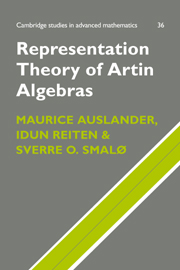Book contents
- Frontmatter
- Contents
- Introduction
- I Artin rings
- II Artin algebras
- III Examples of algebras and modules
- IV The transpose and the dual
- V Almost split sequences
- VI Finite representation type
- VII The Auslander–Reiten-quiver
- VIII Hereditary algebras
- IX Short chains and cycles
- X Stable equivalence
- XI Modules determining morphisms
- Notation
- Conjectures
- Open problems
- Bibliography
- Relevant conference proceedings
- Index
V - Almost split sequences
Published online by Cambridge University Press: 11 May 2010
- Frontmatter
- Contents
- Introduction
- I Artin rings
- II Artin algebras
- III Examples of algebras and modules
- IV The transpose and the dual
- V Almost split sequences
- VI Finite representation type
- VII The Auslander–Reiten-quiver
- VIII Hereditary algebras
- IX Short chains and cycles
- X Stable equivalence
- XI Modules determining morphisms
- Notation
- Conjectures
- Open problems
- Bibliography
- Relevant conference proceedings
- Index
Summary
In this chapter we give an introduction to almost split sequences, a special type of short exact sequences of modules which play a central role not only in this book, but also in the representation theory of artin algebras in general. Almost split sequences are introduced via the dual notions of left almost split morphisms and right almost split morphisms. These notions give rise not only to almost split sequences but also to the equally basic concept of irreducible morphisms. In this connection the radical of the category mod Λ, which is an R-relation on mod Λ, is studied. In addition to the general theory, various examples and special types of almost split sequences are discussed, including a method for constructing almost split sequences for modules over group algebras of finite groups.
Almost split sequences and morphisms
Even though until now our major emphasis has been on studying modules, we have also discussed some special types of morphisms, such as projective covers, injective envelopes and right and left minimal morphisms. In this section we introduce some other special morphisms, called right and left almost split morphisms, which give rise in a natural way to the notion of almost split sequences. The section ends with a proof of the existence and uniqueness of almost split sequences.
Even though it is not quite grammatically correct, we say that a morphism f:B → C is a split epimorphism if 1c:C → C, the identity morphism of C, factors through f.
- Type
- Chapter
- Information
- Representation Theory of Artin Algebras , pp. 136 - 190Publisher: Cambridge University PressPrint publication year: 1995

